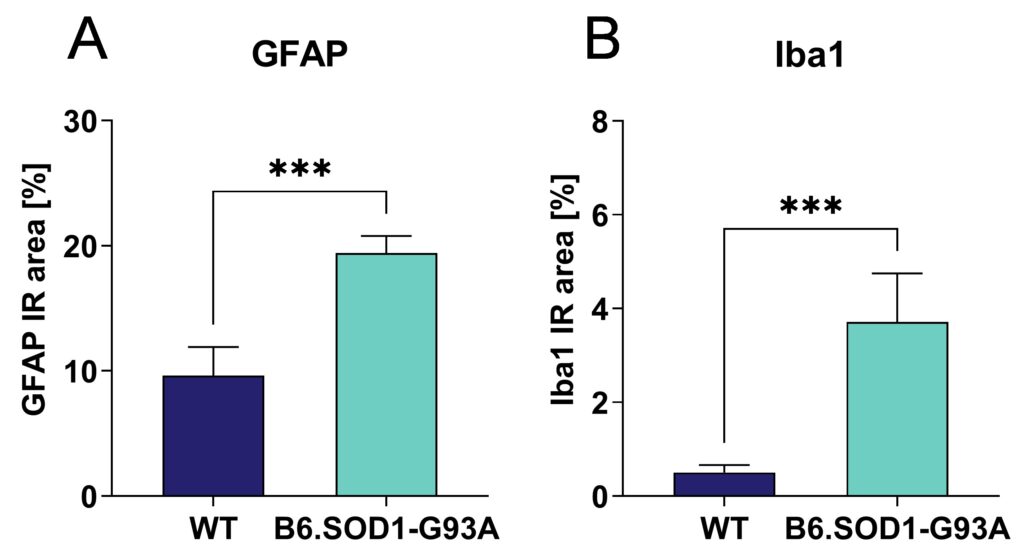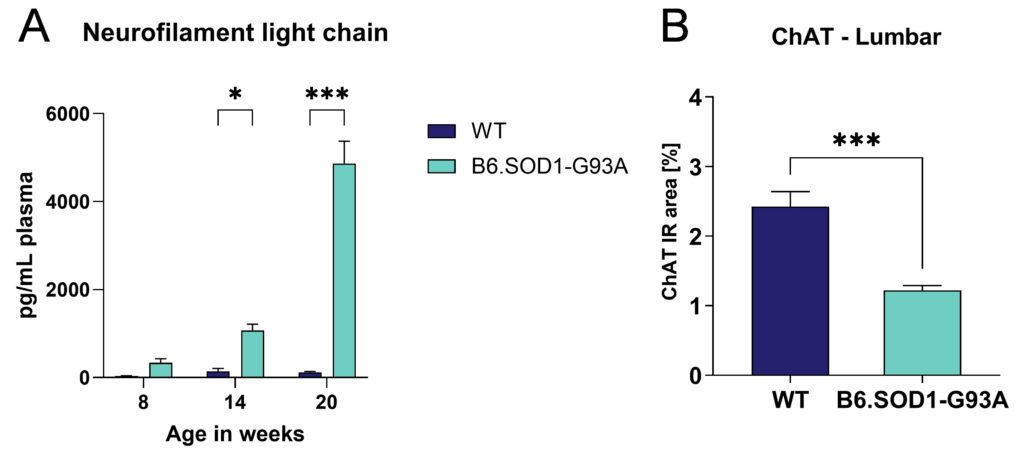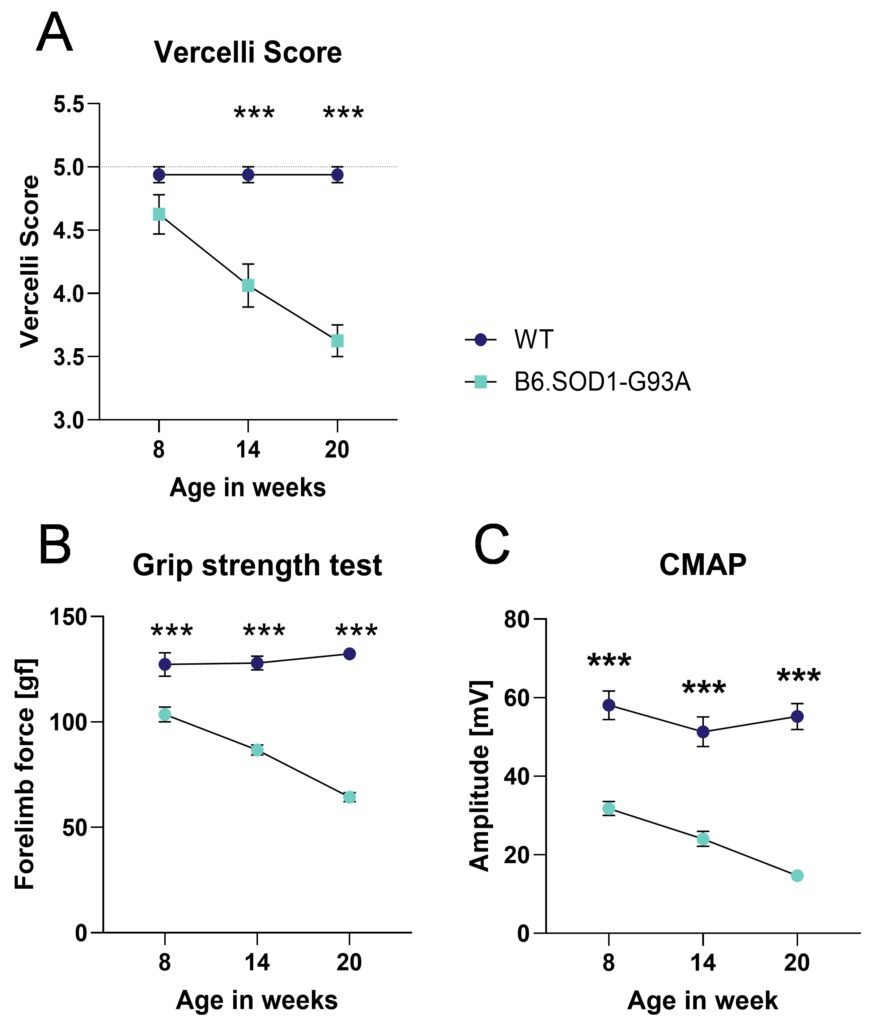B6.SOD1-G93A mice express the human SOD1 with G93A mutation under the regulatory control of the cistronic human SOD1 promoter, similar to SOD1-G93A mice but on a pure C57BL/6J background. This difference results in a slower disease progression in B6.SOD1-G93A mice. Mutations in the SOD1 gene have been linked to familial amyotrophic lateral sclerosis (ALS or Lou Gehrig’s disease).
The most important characteristics of B6.SOD1-G93A mice are:
- Muscle tension
- Muscle weakness
- Motor coordination deficits
- Neuroinflammation
- Neurodegeneration
- Autophagy
- Oxidative stress
Evaluation of neuroinflammation in B6.SOD1-G93A mice showed a significantly increased immunoreactive area for the astrocytic marker GFAP (Figure 1A) and the microglia marker Iba1 (Figure 1B) in the cervical spinal cord of B6.SOD1-G93A mice at the age of 20 weeks. Similar differences were observed in the thoracic and lumbar spinal cord (data not shown).

Figure 1: Neuroinflammation in the cervical spinal cord of B6.SOD1-G93A mice. GFAP (A) and Iba1 (B) immunoreactive (IR) area in percent indicating astrocytosis and microgliosis, respectively, in the cervical spinal cord of B6.SOD1-G93A transgenic mice at the age of 20 weeks compared to age-matched wild type (WT) mice. Mean + SEM; n = 8 per group; t-test; ***p<0.001.
Evaluation of neurodegeneration in B6.SOD1-G93A mice showed significantly increased neurofilament light chain levels in the plasma of B6.SOD1-G93A mice starting at the age of 14 weeks (Figure 2B). Furthermore, a significant decrease in the immunoreactive area of ChAT, labelling cholinergic neurons, in the lumbar spinal cord could be observed, indicating neuronal loss (Figure 2B). A reduced ChAT-positive immunoreactive area could also be observed in the thoracic, but not the cervical spinal cord (data not shown).

Figure 2: Neurodegeneration in B6.SOD1-G93A mice. A: Neurofilament light chain (NF-L) levels in the plasma of B6.SOD1-G93A transgenic mice at the age of 8, 14, and 20 weeks. Two-way ANOVA with Bonferroni’s post hoc test. B: ChAT immunoreactive (IR) area in percent indicating neuronal loss in the lumbar spinal cord of B6.SOD1-G93A transgenic mice at the age of 20 weeks compared to age-matched wild type (WT) mice. T-test. A and B: Mean + SEM; n = 8 per group; *p<0.05; ***p<0.001.
Analysis of the muscle deficits and motor coordination in B6.SOD1-G93A mice showed first significant differences at the age of 8 weeks (Figure 3). The ability to voluntarily sustain muscle tension was measured with the Vercelli scoring system, showing first significant differences of B6.SOD1-G93A mice at the age of 14 weeks (Figure 3A). Muscle weakness was evaluated with the grip strength test resulting in significant deficits in B6.SOD1-G93A mice already at the age of 8 weeks (Figure 3B). Evaluation of the compound muscle action potential (CMAP) as indicator of electromyographic changes resulted in very early deficits in B6.SOD1-G93A mice (Figure 3C). Although the youngest analyzed animals were 8 weeks old, results indicate that changes in grip strength and CMAP might start even earlier.

Figure 3: Muscle deficits and electromyographic changes in B6.SOD1-G93A mice. Vercelli score (A), indicating the ability to voluntarily sustain muscle tension, grip strength test (B) indicating muscle weakness, and amplitude of the compound muscle action potential (CMAP, C) during electromyographic measurements of B6.SOD1-G93A mice at the age of 8, 14, and 20 weeks compared to age-matched wild type (WT) mice. Two-way ANOVA with Bonferroni’s post hoc test; n = 16/group; mean ± SEM; ***p<0.001.
B6.SOD1-G93A mice present typical ALS symptoms are therefore a valuable model for preclinical research of this devastating neurodegenerative disease. The phenotype onset of B6.SOD1-G93A mice seems comparable to the classic SOD1-G93A mouse model, but disease progression seem slower, providing a longer treatment window for pharmacological interventions.
Scantox offers a custom-tailored study design for B6.SOD1-G93A mice, and we are flexible to accommodate your special interests. We are also happy to advise you and propose study designs. B6.SOD1-G93A mice show a relevant ALS phenotype at the age of 8 weeks. Furthermore, non-transgenic littermates are available as control animals needed for proper study design.
We are happy to evaluate the efficacy of your compound in the B6.SOD1-G93A mouse model!
The most common readouts are:
- Clinical signs / Vercelli Score
- Motor deficits
- Muscle weakness
- Oxidative Stress
- Neuroinflammation
- Neurodegeneration
You might also be interested in these related topics:
We are happy to receive your inquiry.


